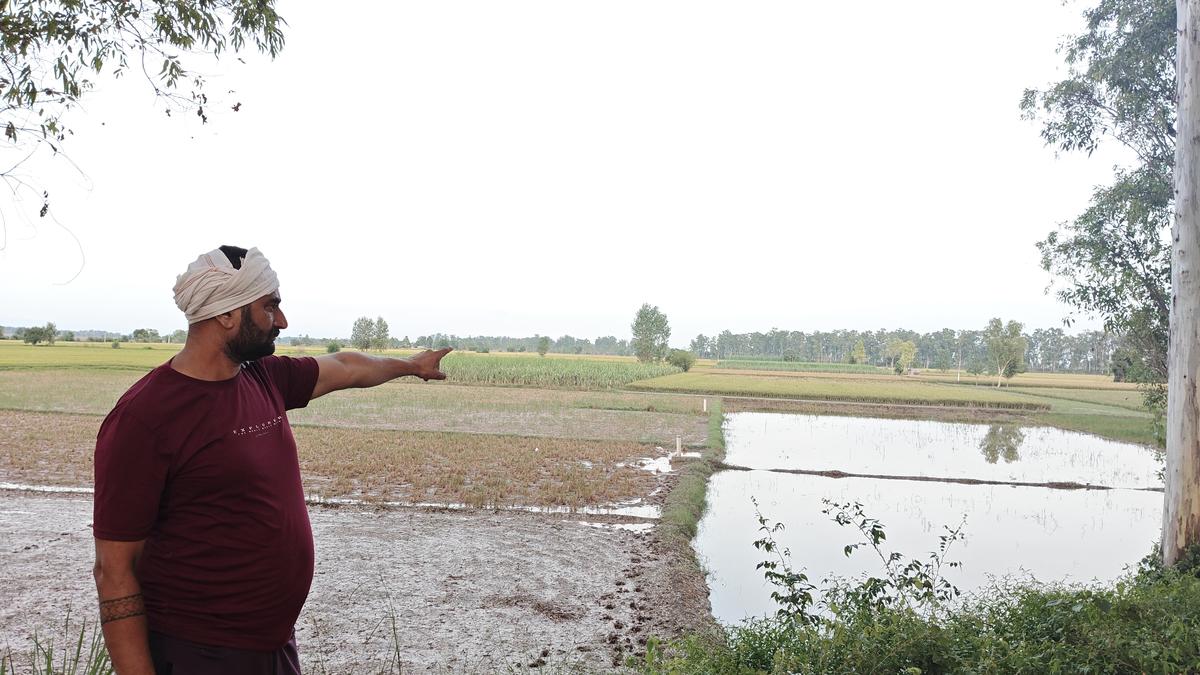Naseeb Singh, 28, who farms over 17 acres of land in a village near Dera Baba Nanak town in Gurdaspur, came across a strange problem when he inspected his farm following the recent floods — nearly two acres of his field had turned into a pit full of floodwater and the rest was covered with silt.
Standing next to a broken embankment on his farmland near the India-Pakistan border, Mr. Naseeb said, “The bandh (embankment) broke at night, and the force with which the water gushed in created this pit, which is about 30-40 feet deep. The rest of my field was covered under over five feet of silt. We have been working to clear it for the past two weeks.”

The farmer estimates his losses at over ₹50 lakh. “I have no idea how to pay back my loans amounting to ₹10 lakh,” he said.
In August and September, Punjab faced one of its worst floods in decades, affecting more than 20 lakh people across 2,614 villages and displacing 6.87 lakh people.
Farmers in several villages near the Ravi river in Amritsar and Gurdaspur districts of north-west Punjab shared similar stories of farmland destruction and crop losses amid complaints of apathy from the Central and State governments.
According to Punjab government data, floods have hit around 2 lakh hectares of farmland, which is less than 5% of the total area sown during the kharif season.
Last month, the State government announced a compensation of ₹10,000-₹20,000 per acre, depending on the extent of damage. However, the assistance is yet to be released.
When contacted, the ruling Aam Aadmi Party said the compensation announced by the Punjab government is “unmatched”. “For the first time, we have set a 45-day bracket, within which we will complete girdawari (inspection) and ensure every affected person receives the compensation cheque,” read a statement issued by the party.
Help by volunteers
Most of the affected farmers The Hindu spoke to said they had suffered losses running into lakhs of rupees and expressed concern over mounting interests on their existing loan.
Many also said that they were likely to miss the rabi sowing season in November given the extensive work required to restore their land, made all the more difficult by the shortage of money and labour.
At his field, where two tractors and one bulldozer are working to clear the silt and fill the pit, Mr. Naseeb said dozens of volunteers, mostly farmers from Punjab, Haryana, and Uttar Pradesh, have been working tirelessly with him free of cost. “Without them, I could not have managed anything. The government has not done anything for us yet,” he said.
Two of his friends have been helping Malki Singh, 36, in removing silt from the field in Hoshiarpur. “When we came here, there was six to eight feet of silt on the land. We have been working here for about a week.”
He added that he, along with others, has been doing “seva (volunteer work)” for the past one-and-a-half months in various flood-affected villages in the area.
Amrik Singh, a 45-year-old father of three children, said his entire cauliflower crop, spanning four acres of land, was washed away in the flood. “I lost about ₹14 lakh in the calamity. I had taken ₹1 lakh loan from the bank and ₹50,000 loan from an aartiya (middleman) for expenses in sowing the crop. Now I’m thinking of selling one or two of my three buffaloes to pay them back at least some of the loan,” he said.
“Kuch madad milega (will I get some help),” he asked at the end of the conversation.
At Ghonewala village in Amritsar, there are several cases of floods breaching embankments along farmlands and causing the fields to be covered with silt. While some fields are still completely filled with floodwaters, others have standing paddy, but the produce has been affected.
Surjeet Singh, 47, stands next to his one-acre field, most of which turned into a deep pit due to the breach. “Just in our village, the bandh has broken in about 10 different areas. A similar situation prevails in every village in this belt close to the river,” he said.
At the village, several gurdwara committees are assisting in rebuilding the broken embankments, even as the affected farmers wait for government assistance.
Mounting debt
Nishand Singh, 40, stands next to his nine-acre field, part of which is still flooded while the paddy crop stands on the rest. “The standing crops have very little grain. I will have to plough it back into the soil. There is no point in spending money on harvesting it.”
The farmer said that he had taken ₹7-lakh loan from a bank, but the ₹2.5 lakh he has borrowed from a middleman will hurt him more as it came at an interest rate of 24% per annum.
“The State and the Central governments have done nothing so far. The official machinery is completely missing from the ground. No compensation has been given yet. Only an announcement has been made; that too is too little,” said Baljit Singh Grewal, general secretary of the All India Kisan Sabha (Punjab unit).
Mr. Grewal said that the government should immediately distribute the compensation in cash, as farmers are reeling under severe distress.
“Farmer unions and the general public are stepping forth to fix the broken embankments while officials are nowhere to be seen,” he said.
In Paharipur village of Pathankot, floodwaters have receded from the fields, but farmers say the standing crops seem fine only from a distance.
Published – October 11, 2025 03:33 am IST


